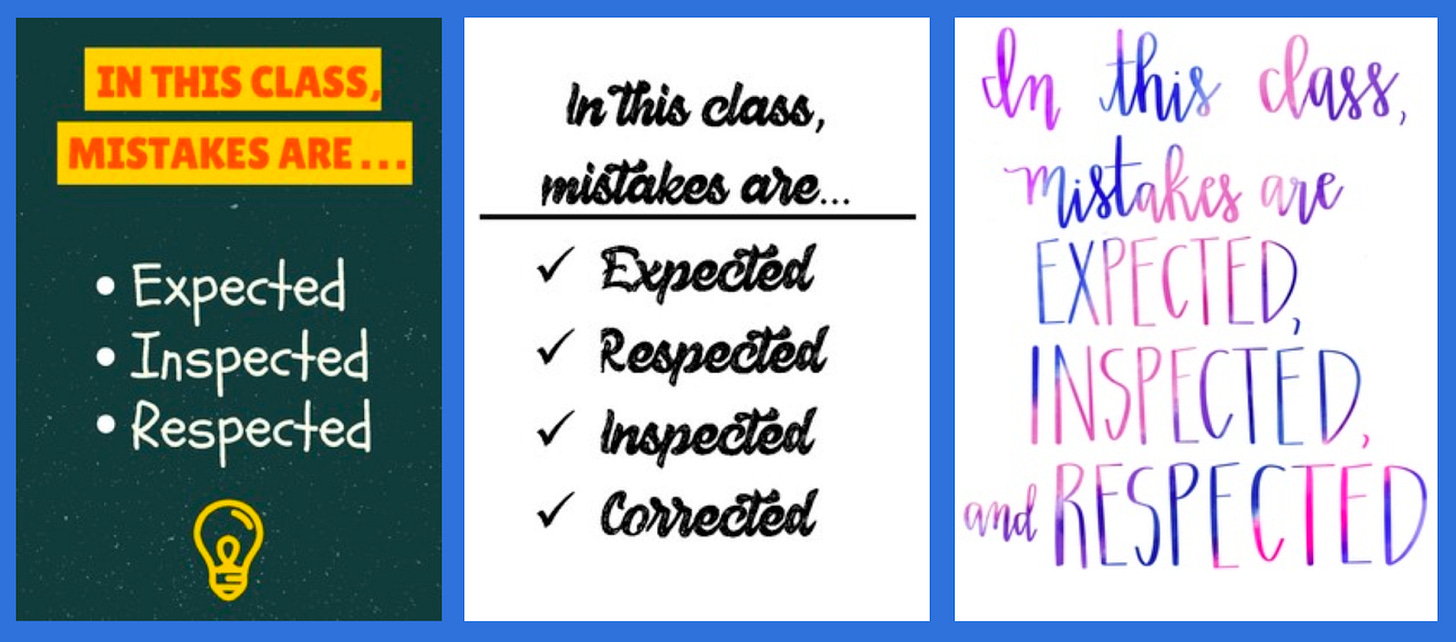Help Students Remember the Right Answers by Asking for the Wrong Answers First
The “Derring” Effect
If the math education community has aligned on anything in the last ten years, it is the idea that students should not feel ashamed about their incorrect answers. Teachers seem to understand more deeply than ever how the fear of being wrong can inhabit their classrooms and inhibit mathematical thought. You can commonly hear teachers say, “In this class, mistakes are expected, inspected, and corrected” and you can just as commonly find that same statement on posters sold across the internet.
It’s great that wrong answers receive so much positive attention in math classes lately, but we should hope for more of that attention to leap off the posters and transform from word into deed. This attention often seems reactive, for example. “We will be sure to treat wrong answers kindly if they appear,” is the implication of these posters.
Recent research suggests we should consider wrong answers more proactively, effectively adding “requested” to those posters.
Psychologist Sarah Shi Hui Wong has identified significant value in asking students for wrong answers, in asking them to deliberately err or to “derr.” Wong asked students to study several neuroscience terms and their definitions before trying to recall them on a test. Three groups of students saw the correct definition of a term, and then Wong gave each group different instructions.
Copy the definition down and underline what they felt was a key element of the definition. (Copy.)
Copy the definition, introduce a conceptual error into the definition, and strike it out. (Error-Cancel.)
The same as Error-Cancel but correct the error. (Error-Correction.)
On tests of recall, the groups with deliberate errors performed significantly better than the group with errorless copying.
Wong also performed some follow-up experiments to rule out the possibility that these results were an artifact of students doing more effortful work in the “error” conditions than the “copy” condition. She also found in a later study that students in the “error” conditions were able to transfer their learning more readily to other contexts.
What does it mean?
The space of a problem is full of wrong answers which students are taught to avoid in favor of the smaller number of correct answers. This wastes an opportunity. Students who cannot identify a right answer yet often know enough about it to identify a wrong answer.
For example, watch Colin Campbell ask his students to deliberately create a car that won’t fit the given constraints in one of our lessons.
Or ask students a question like “How many regular gummy bears would make a super bear?” but first ask them for a wrong answer. Ask them for a number of regular gummy bears that they know is too high or too low.
Many of the students who cannot find the precise solution of a system of equations can tell you a point that is not the precise solution. You could evaluate that non-solution in each equation, helping students start to connect the graph, the equations, and the solution space.
Classroom teaching is incredibly challenging work, work which teachers can make easier for themselves when they recognize and use the resources that are available throughout their classrooms. It is easy to recognize fully formed and fully correct ideas as resources when they appear. But those resources are less common, and possessed initially by only a small number of students. Many more students possess wrong answers and Wong’s research shows us how those answers, too, can be a resource for teachers.
When have you found it useful to request wrong answers from your students?
[via Efrat Furst]







This was great! I think perhaps the most common way teachers (not merely in math) use this is, unfortunately, too limited and late. That is when they write distractors for multiple choice questions. Because we know the kind of mistakes kids are likely to make, we make sure our distractors seem plausible to students, so as to identify which students know their stuff most thoroughly.
But Dan's post today makes me realize what an opportunity I've been missing. I've long taken not a small amount of pride in how well I've taught my students to deal with mistakes, even getting excited over a particularly common error and having kids think through what "Matthew" was thinking when he got that wrong. But this is really great, asking them to actually SEEK possible misavenues of thought. I definitely need to try to work this into my teaching.
I ask, "Wrong answers only!" when students are nervous, and that does help. I've also asked students to make as many mistakes as they possibly can in one exercise, or make as bad a mistake as they can. These tasks require some meta-cognition: What makes a mistake bad? Where exactly can our math go horribly wrong, and how?
More broadly, it's important to ask students to generate "many" (three or more) examples of their own whenever they meet a new math object. They also need to make many NON-examples! (And counter-examples, if we are working with logic and proofs.) Making non-examples is similar to requesting mistakes, as pedagogical principles go. Both invite meta-cognitive reflection and increase mathematical confidence.